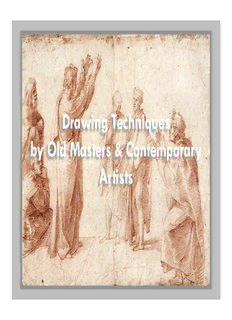
Drawing Techniques by Old Masters & Contemporary Artists PDF
Preview Drawing Techniques by Old Masters & Contemporary Artists
Drawing Techniques by Old Masters & Contemporary Artists A beautiful, sensuous surface is one of the principle goals of meticulous drawing. For the past 500 years, certain artists in each era have maintained fine rendering and attention to surface as a priority in their work. Making these beautiful drawings requires different skills from making good paintings. Many talented painters lack the light touch and sensitivity to produce a sensuous surface on paper. Perhaps the ultimate tool in the meticulous technique is a medium called "silverpoint". The characteristics of silverpoint are: 1) subtlety of tone in the lighter end of the tonal scale 2) single-hatch drawing resulting in an extremely uniform, sensuous surface Artists, whether Old Master or contemporary, who are most successful in silverpoint drawing are those with a deep concern for beauty of surface. So an artist such as Leonardo, who was perhaps the most sensitive draftsperson in all art history, is much more successful in silverpoint than an artist such as Michelangelo who is relatively heavy-handed in his drawing. The influence of the great Italian Renaissance artist Michelangelo spread far beyond his own time. His red chalk study for one of the figures on the Sistine Chapel ceiling is an extraordinary example of his conception of the idealized male nude. In making his drawing, Michelangelo depended both on the live model and on his understanding of the idealized anatomy of classical sculpture. Although the two poses are very different, both have forward curving torsos that emphasize the muscles of the chest and abdomen. The pose comes from a famous fragment of classical sculpture that both artists knew, the Belvedere Torso. Michelangelo Buonarroti (Italian, 1475-1564) Study for the Nude Youth over the Prophet Daniel, 1510-11 Red chalk, 13 3/16 x 9 3/16 inches Annibale Carracci understood this as well when he drew his figure o f H e r c u l e s a l m o s t o n e hundred years later. Annibale Carracci (Italian, 1560-1609) Hercules Resting, 1595-97 Black chalk heightened with white, squared in black chalk on right, 13 15/16 x 20 5/8 inches Hatching is the repetition of parallel lines to create broad areas of tone, as we see in this detail of a leg in a Michelangelo figure drawing. In Cross hatching the artist adds another series of lines that cross the first set, creating even denser areas of tone, as seen in Dürer's arm of Eve. Michelangelo Buonarroti (Italian, 1475-1564) Detail from Study for the Nude Youth over the Prophet Daniel, 1510-11 (recto) Albrecht Dürer (German, 1471-1528) Red chalk and black chalk on beige laid paper, 13 Detail from Arm of Eve, 1507 3/16 x 9 3/16 inches Point of brush and gray and black wash, brush and Figure Studies for the Sistine Ceiling (verso) gray and black wash,heightened with white gouache, Red chalk heightened with traces of white on blue laid paper, 33.4 x 26.7 centimeters Made almost four centuries apart, these two sheets show how the tradition and function of drawings has been continuous in the history of Western art. Durer and Degas both drew in order to understand how to convincingly render the arm of a female figure they planned to use later in a finished oil painting. However, they used very different techniques to achieve this end. Both artists wanted to understand how light falls on a form and how to make it appear three-dimensional. Durer used a network of lines—known as crosshatching—made with the point of a brush. Degas, on the other hand, used black chalk, which he could blend to make subtle tonal variations. Edgar Degas (French, Albrecht Dürer (German, 1834-1917) 1471-1528) Angel Blowing a Arm of Eve, 1507 Trumpet, 1857-59 Point of brush and gray Black chalk, 17 æ x 21 and black wash, 15/16 inches heightened with white Gift of the Print Club of gouache, 13 1/8 x 10 ‡ Cleveland 1976.130 inches
Description: